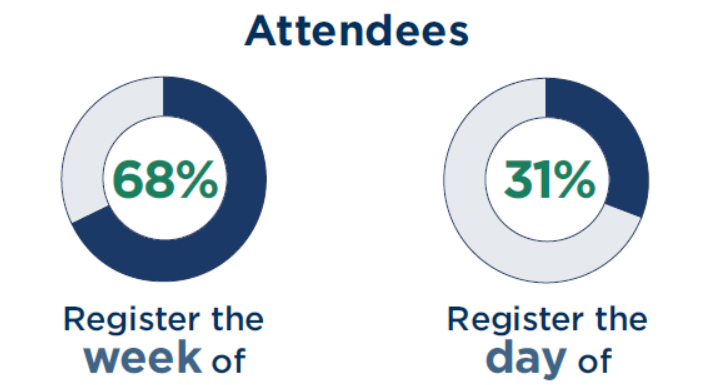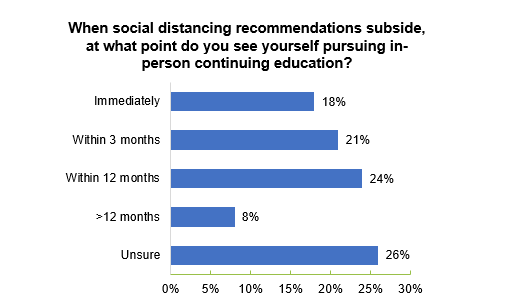Introduction
Essentially overnight, the coronavirus disease 2019 (COVID-19) pandemic shifted the education industry to an entirely web-based format. Prior to the pandemic, Vindico Medical Education executed most educational events live and in-person, with only a small percentage of events being livestreamed from the meeting site. Recruitment efforts focused heavily on sending invitations via postal mail, but they also included emails, web announcements and other advertisements. In this setting, there was a high percentage of pre-registrants who attended the actual event. However, with the shift to virtual education, Vindico saw dramatically different trends in registration and attendance, forcing a change in scheduling and marketing strategies. The implications of these trends will have significant impact as the continuing education (CE) industry enters the next phase of effects from the pandemic — hybrid education.
Results
From 2017 to 2019, 59% of Vindico’s live, in-person, non-association meetings were scheduled to take place on weekends. Most attendees registered 2–6 weeks before the in-person activity, with very few week-of and day-of registrants. Seventy-four percent of all registrants attended the event.
From March to December 2020, Vindico provided 63 standalone webinars that were not scheduled in conjunction with association meetings. The number of registrants for virtual webinars was, on average, 10 times higher than that observed for in-person education. For webinars, most (68%) registrants registered the week of, and 31% had registered the day of the webinar (Figure 1). The percentage of those who attended (attendance rate) was highest (63%) among those who registered the day of the meeting.
Figure 1

Pie charts illustrating the percentage of registrants who registered the week of or day of the webinar. N=63 independent webinars.
Besides the timing of registration, several additional trends on attendance rates were observed, including the following:
- Time of day: Attendance rates were highest for webinars scheduled over lunchtime (11 a.m.–1 p.m.) or in the evening (after 5 p.m.) in EST.
- Day of week: Attendance rates are consistent regardless of the day of week the educational event occurred (range: 37% on Thursdays to 47% on Mondays).
- Month of year: Attendance rates were lowest in September (36%) and December (21%) versus other months (average 45%).
- Time zone: Attendance rates were lowest for learners on PST (34%) versus learners in other time zones (average 42%).
- Credit length: Attendance rates were 34% for 1.0-credit hour programs and 45% for programs between 1.25 and 2.0 credit hours.
Discussion
Several possible causes underlie the lower percentage of registrants who attended webinars versus in-person CE events. Informal polling of our learners has identified reduced costs, no travel requirement and fewer home distractions (e.g., family members, pets, television, social media) as major drivers for not attending after pre-registering for a live webinar.
Interestingly, Vindico saw little impact on attendance rates related to the day of week of a CE event, yet time of day and month of year were influential. Early on, we tried to schedule webinars at various times of the day to accommodate all time zones. However, we found that activities occurring during lunchtime and in the evening hours in EST had the highest attendance rates, but this also could be due to the greater number of attendees on the East Coast.
Alternatively, it may be easier for a learner on the West Coast to attend a program in the early morning than it is for a learner on the East Coast to attend a program late into the evening. Going forward, Vindico will try to not schedule multiple broadcasts of the same educational session to accommodate various time zones and instead will focus our efforts on offering more webinars over lunchtime and evening hours on East Coast time. Similarly, we will schedule fewer webinars in September and December, which had the lowest attendance rates that likely are due to the busy back-to-school and holiday seasons.
A greater understanding of COVID-19 and the increased availability of effective vaccines has had a recent positive impact on the pandemic, particularly on healthcare providers. However, the future of CE, at least for the next few years, will likely be a hybrid approach to learning — offering live education both in-person and via virtual streaming. Indeed, in a poll of our network of healthcare providers, only 18% indicated that they plan to return to live education immediately after social distancing guidelines subside, with 37% now preferring virtual education to live education. (Figure 2).
Figure 2


Graphs illustrating the polling results from attendees of live virtual webinars in 2020 and their plans regarding time of return to in-person education (top) and preferences for virtual versus in-person education (bottom) since the onset of the pandemic. N=1,058.
To this end, recruitment and attendance efforts for hybrid events should ideally blend in-person and virtual activities strategies. To generate in-person learners, postal invitations and emails should still be sent in advance of the activity date, targeting potential learners who live in proximity to the activity location. Virtual learners should be invited closer to the activity date via web advertisements and emails, regardless of location. Pre-registrants for both types of activities will receive reminder emails, telephone calls and/or text messages to increase retention. Chat rooms, video or audio call-ins, as well as capturing and displaying virtual attendee polling responses on-site, should be utilized to engage virtual attendees.
Conclusion
Essentially overnight, the COVID-19 pandemic shifted in-person CE learning to virtual education. However, analysis of in-person educational programs prior to March 2020 and virtual programs for the duration of 2020 elucidated disparate trends in registration and attendance. These findings will have significant impact on the scheduling of webinars and hybrid education throughout 2021 and into the coming years.